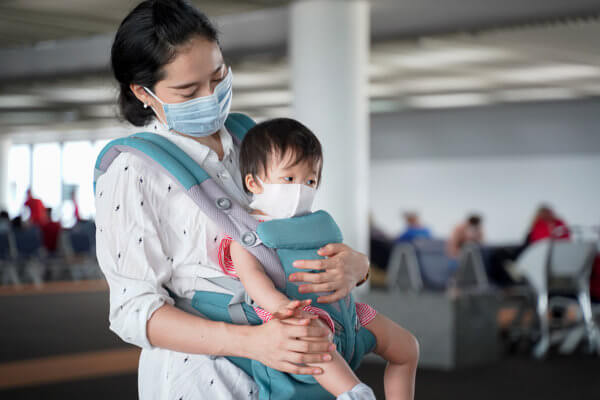By Nancy Gottesman
Your baby’s immune system is designed to recognize and fight invading germs, called antigens. A vaccine contains weakened versions of these disease-causing antigens. The vaccine’s antigens prompt your baby’s immune system to produce protective antibodies, which fight off unwelcome bacteria and viruses. The happy result is that your baby gains immunity without having to endure the disease. “The real key to vaccination is that your body makes cells that remember how to produce these protective antibodies in a big hurry if and when the real living germ enters your body,” explains Sharon Humiston, M.D., M.P.H., a pediatrician in the department of emergency medicine at Golisano Children’s Hospital at the University of Rochester Medical Center in New York. “It’s an ingenious system!”
Your baby’s shot schedule
KEEP TRACK OF YOUR BABY’S VACCINES. PRINT OUR VACCINE SCHEDULE HERE.
Vaccines are a must to protect your infant from 14 preventable diseases! The reason for so many shots the first year is that it takes several doses for a baby to achieve full immunity. (Some vaccines, like tetanus, don’t confer lifelong protection, so your child will need booster shots every decade or so.) Here are the vaccinations your baby needs in his first year, and why.
Hepatitis B vaccine
When: At birth, 2 and 6 months old
Why your baby needs this: It can begin protecting your baby right away against the serious liver disease, which is spread through contact with the blood of an infected person. If a mother has hepatitis B, her infant can be exposed at birth, so it is given as soon as a baby is born to prevent contraction of the disease.
NEXT: DTaP vaccine (diphtheria, tetanus, acellular pertussis)
{pagebreak}
DTaP vaccine (diphtheria, tetanus, acellular pertussis)
When: At 2, 4, 6 and 12 months old
Why your baby needs this: This combined vaccine wards off diphtheria (a bacterial respiratory disease now rare in the U.S.), tetanus (aka lockjaw, a nervous system infection) and pertussis (whooping cough). It’s vital because pertussis, a highly contagious bacterial infection that’s very dangerous for infants, has reemerged in pockets of the U.S.
NEXT: Hib vaccine (Haemophilus infl uenzae type b conjugate)
{pagebreak}
Hib vaccine (Haemophilus infl uenzae type b conjugate)
When: At 2, 4, 6 and 12 months old
Why your baby needs this: Hib is a serious bacterial infection that occurs mostly in infants. Complications include meningitis, pneumonia, sepsis, severe throat infection and arthritis, and can result in permanent brain damage, even death. Common in the 1980s, meningitis is now rare in the U.S., thanks to this vaccine.
NEXT: Pneumococcal conjugate vaccine (PCV)
{pagebreak}
Pneumococcal conjugate vaccine (PCV)
When: At 2, 4, 6 and 12 months old
Why your baby needs this: It protects your infant from contracting a bacterial infection that causes pneumonia, blood poisoning and meningitis, and is one of the most common causes of death in the U.S. from a vaccine-preventable disease. Since 2000, when American children began receiving this vaccine, the rate of hospitalization due to pneumococcal pneumonia has declined 58 percent in children under 2 years old.
NEXT: Rotavirus vaccine
{pagebreak}
Rotavirus vaccine
When: At 2, 4 and 6 months old
Why your baby needs this: Rotavirus, whose symptoms include fever, diarrhea and vomiting, is the most common cause of acute gastroenteritis in kids, causing the deaths of more than 600,000 children outside the U.S. yearly. Since 2006, when this vaccine was recommended for routine use on American infants, rotavirus prevalence has dropped by 50 percent in our country. This very effective vaccine now prevents 74 percent of all cases, 98 percent of severe cases and 96 percent of hospitalizations due to rotavirus.
NEXT: Inactivated poliovirus vaccine (IPV)
{pagebreak}
Inactivated poliovirus vaccine (IPV)
When: At 2, 4 and 6 months old
Why your baby needs this: A viral disease that can lead to paralysis and death, polio has not been reported in the U.S. for 20 years thanks to the vaccine, which was introduced in 1955. If we weren’t protected by this vaccine, however, it would take just one case of polio from another country to bring the disease back.
NEXT: Influenza vaccine (aka “flu shot”)
{pagebreak}
Influenza vaccine (aka “flu shot”)
When: Given to babies who are at least 6 months old in autumn and winter, and every year thereafter
Why your baby needs this: On average, 226,000 people are hospitalized every year because of influenza, which can cause high fever, diarrhea and seizures in young children. The vaccine can protect your baby from this very serious illness, but it doesn’t prevent colds and coughs caused by other “flu-like” viruses.
NEXT: MMR vaccine (measles, mumps, rubella)
{pagebreak}
MMR vaccine (measles, mumps, rubella)
When: At 12 months old
Why your baby needs this: It protects against three highly infectious diseases: measles, mumps and rubella (German measles). Although these diseases are no longer common in the U.S., sporadic outbreaks (including the spread of measles in 2008 by an unvaccinated San Diego boy who visited Switzerland) illustrate that they can be imported from other countries.
NEXT: Varicella vaccine (chicken pox)
{pagebreak}
Varicella vaccine (chicken pox)
When: At 12 months old
Why your baby needs this: Introduced in 1995, it has dramatically reduced the number of children who are infected, hospitalized or die annually due to chicken pox (which causes blister-like lesions and can result in a bacterial skin infection, brain swelling and pneumonia).
NEXT: Hepatitis A vaccine
{pagebreak}
Hepatitis A vaccine
When: At 12 and 18 months old
Why your baby needs this: It prevents a serious liver disease whose symptoms include jaundice, fatigue, stomachache and nausea. Young children may not have symptoms, so hepatitis A is often not diagnosed in a young child until a caregiver gets ill.
Sites to visit:
American Academy of Pediatrics Centers for Disease Control and Prevention Institute for Vaccine Safety, Johns Hopkins University School of Public Health
Nancy Gottesman and her son, 13, keep their shots current in Santa Monica, Calif.
Everything you need to know about each vaccination.[/vc_column_text][/vc_column][/vc_row]



